Helen H. Moore's Blog, page 328
August 17, 2017
Why the humble “Logan Lucky” is the most important film of the year
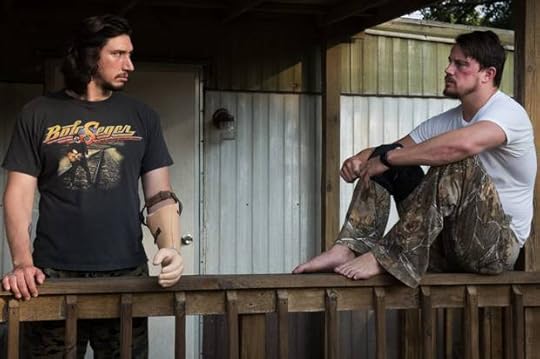
Adam Driver and Channing Tatum in "Logan Lucky" (Credit: Fingerprint Releasing)
“Logan Lucky” is not a transcendent moviegoing experience, nor is it a stylistic breakthrough or a grand statement on existence, love or politics.
Its cast is full of established movie stars who, for the most part, look like they could’ve been movie stars in any era. The film is not one of director Steven Soderbergh’s finest, nor is it one of his worst. It is not a film that Soderbergh intended to be “serious” or “important.” He did not make it with the hopes of winning an Oscar, and he likely won’t.
Still “Logan Lucky” may very well be the most significant film of the year. Indeed, it’s “Logan Lucky” — not “Baby Driver” — that is the one movie being released in 2017 that has the potential to change Hollywood.
I have argued before that the notion that cinema is dead is laughable. When all is said and done, I think that this year will be remembered as a particularly good one for filmmaking, a testament to the medium’s continued vitality.
Regardless, its true that making a mid-budget original studio film outside of awards season is a trickier proposition now more than ever. Intel from Actors, filmmakers and data bear out this 21st-Century trend. (Soderbergh did a good job of explaining why that is in his 2013 keynote at the San Francisco International Film Festival.)
Soderbergh’s answer to what he perceived as the demise of cinema was first to retire, then to make television. Now, he’s returned to upend the process. With “Logan Lucky,” Soderbergh tests a new way to make a studio movie: rely on the studio as little as possible.
You can read a detailed recap of what Soderbergh is doing in The New York Times, but basically it’s this: Soderbergh, with help from a former Warner Bros. executive named Dan Fellman, sold the film’s foreign rights in advance to finance the production; he then sold everything else (streaming rights, television rights, airplane replays, etc.) to finance the film’s advertising and printing in conjunction with upstart Bleecker Street Media. After all of that wheeling and dealing, he was left with creative control, including over the film’s marketing, and half the box office money for himself and his partners.
“There’s no intermediary,” Soderbergh explained to GQ. “The money is not passing through anybody’s hands. All these people who work for scale to make this film will literally be able to go online with a password and look at this account as the money is delivered from the theaters. So it’s complete transparency. The question is: Can we put a movie out in 3,000 theaters, and spend half of what a studio would spend to do it, and succeed?”
Whereas the high costs of marketing a typical studio film require that the film earns multiples of its budget almost immediately, “Logan Lucky,” which was reportedly made for $29 million, only needs to open to approximately $15 million, an easy target in the late-summer market (current tracking puts it between $5 and $12 million, but its word-of-mouth is better than any other films debuting this weekend.)
If the film clears that low bar of success, it could inspire other filmmakers to make the same gamble. “We know that a lot of big-time filmmakers are watching this,” Fellman told the Times. “We want this to be the beginning of a bunch of movies.”
One film, of course, is not a tremendous sample size. “Logan Lucky” could succeed or fail for any number of reasons. But as far as test cases go, it’s a good one. The film is thoroughly fun and never too brainy or experimental; it relies on proven commodities in the form of its stars, its heist plot and its conventional three-act structure; and it will be released August 18, making “The Hitman’s Bodyguard” its only notable competition. If the film succeeds, it will not be because it is an undeniable classic. If it fails, it will not be because of untested variables or tremendous competition.
Steven Soderbergh is playing moneyball with moviemaking. “Logan Lucky” just needs to get on base.
“The Glass Castle” author Jeannette Walls wanted to be “a woman without a past”
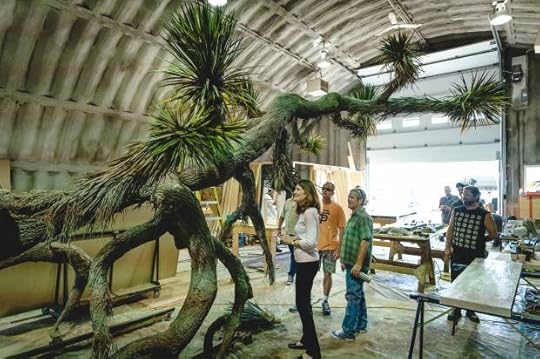
Author Jeannette Walls on the set of THE GLASS CASTLE. (Credit: Jake Giles Netter)
“You know, I thought I could be a normal woman, or a woman without a past,” said Jeannette Walls in a recent interview for “Inflection Point.” “I just wanted for once in my life to be defined by what I did instead of who my parents were — the crazy alcoholic dad and the loopy artistic mom who were always creating a scene and creating chaos.”
Walls’ memoir “The Glass Castle” came out about a decade ago, and if you haven’t picked it up yet, it’s truly a must read. And now it’s a “must-see” movie starring Woody Harrelson, Brie Larson and Naomi Watts.
In her memoir, Walls shares the story of her childhood in almost shocking detail. And even though it has been at least 10 years since I read it, a few things have always stuck with me that you probably remember, too, if you’ve read her book: Every time I boil water, I think of her cooking hotdogs and catching her clothes on fire at age three or four, which landed her in the hospital. And every time I make a well-intended but perhaps unrealistic promise to my kids, I think of Jeannette’s father who had grand plans for a glass castle that was never to be. And when I make cookies, I think of the time Jeannette and her siblings ate margarine and sugar for dinner because there was nothing else to eat in the house. She told me:
I think it hit my kid sister the hardest because she spent a lot of nights at the neighbors’ houses and then she’d come back and say “why don’t we have any food here?”
I mean we had no running water. The house was literally falling down. It was falling down on my brother. We shared a bedroom and his his side of the room had collapsed. It was bad.
It would be easy to hear Jeannette’s story and feel a kind of distant fascination with the life she and her family led — to hold it at arm’s length and think, wow, I can’t even imagine living the way she did. And you can see why she would want to be “a woman without a past.” But for me, whose childhood was nothing like hers (I had a stable home and food on the table, for starters), her story and her relationship with her dad still resonated with me. For one thing, he taught her how to hold her fists to stand up to bullies, which I appreciated because my dad taught me not to take any bull.
Every teen wants to get away from her parents at some point. I moved out to go to college with the full blessing of my parents, a strong work ethic and a fairly full savings account; Walls had to run away to go to college with only her strong work ethic and pretty much the clothes on her back.
Walls worked her way through school and eventually moved to New York, still staying far from her parents. She became a successful journalist writing a well-loved gossip column, but kept her own story at arm’s length. Until finally it became clear that speaking her truth, and owning her past was the only way to keep moving her life forward. Which brings us to today. The movie about her childhood, “The Glass Castle” was directed by Destin Daniel Cretton and is in theaters now.
Ten years after reading her memoir, and thinking about her story pretty regularly (I know, fan girl), I had the chance to sit down with Jeannette and learn how she rose out of a seemingly impossible situation–and how she came to terms with her parents and her past. You can hear our full conversation here.
LISTEN:
“Moonlight” writer Tarell Alvin McCraney producing TV drama based on his life
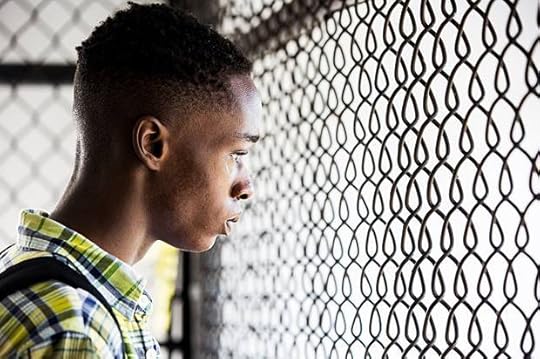
Ashton Sanders in "Moonlight" (Credit: A24)
For Tarell Alvin McCraney, executive producer and co-writer of “Moonlight,” his Academy Award win was just the beginning. This time, McCraney is teaming up with Michael B. Jordan for a coming-of-age drama series to debut on Oprah Winfrey’s OWN.
The series, which McCraney will create, write and executive produce, will be based on his life. “It follows a 14-year-old prodigy from the projects haunted by the death of his closest friend who must choose between the streets that raised him or the higher education that may offer him a way out,” Variety reported. The drama will take place in South Florida, at the closing of President Barack Obama’s presidency. No release date or title has been announced at this time.
“I wanted to explore the pivotal steps towards adulthood and identity, the ones we take when we think or feel we have no other choice,” McCraney said.
“When Tarell shared his powerful story with us there wasn’t a dry eye in the room,” Winfrey said. “I knew this was something special that our viewers will without a doubt connect to and feel compelled to explore with us. I am honored to be working with Tarell and the rest of the producers on this project.”
McCraney was launched into the spotlight with the wide success of “Moonlight,” an adaptation of his partially-autobiographical script originally titled “In Moonlight Black Boys Look Blue.” Aside from the film’s financial and critical success, the Academy Award winner for Best Picture, Best Supporting Actor and Best Adapted Screenplay was revolutionary in featuring an all-black cast and for its nuanced depiction of the intimacy and trauma Chiron experienced as a black gay teen growing up in Miami.
The announcement that more personal work is coming from McCraney is important news for the sake of both quality storytelling and black, queer representation.
Just weeks ago, Netflix started the hashtag and video series #FirstTimeISawMe, where actors were asked about the first time they felt represented on TV. It’s exciting that McCraney will continue to open up space in television for black viewers to see themselves.
Trump rushes to react to terror attack in Barcelona by spreading a fake internet rumor about murdering Muslims

(Credit: Getty/Mark Wilson/Twitter/realDonaldTrumps)
That was quick.
After being widely criticized for his reticence to quickly condemn the neo-Nazis and other white-hate groups that rallied in Charlottesville last weekend, it took President Donald Trump less than three hours after a van rammed through a crowd of people in Barcelona to condemn the attack as an act of Islamic terrorism on his Twitter feed.
On Thursday, at about 5 p.m. local time, a Fiat box van plowed through Barcelona’s La Rambla pedestrian mall, a popular tourist location, killing at least 13 people and injuring dozens, the BBC reported. One suspect was killed in a shootout with police. Reuters reported that the Islamic State terrorist organization has claimed responsibility.
As he has done in the past, Trump showed no hesitancy to condemn Tuesday’s act of terror committed by extremists claiming to be Muslim — likely in a cynical pander to the anti-Muslim bigots that helped him win last year’s presidential election.
The United States condemns the terror attack in Barcelona, Spain, and will do whatever is necessary to help. Be tough & strong, we love you!
— Donald J. Trump (@realDonaldTrump) August 17, 2017
On Saturday in Charlottesville, a Nazi sympathizer was arrested on charges of being the man who drove a car through a crowd of people protesting the “United the Right” white-power rally, killing Heather Heyer, 32, and injuring 19, including five seriously. Virginia officials, U.S. Attorney General Jeff Sessions and others have called the car-ramming incident an attack of domestic terror; the president has not.
Trump followed through about an hour later with a tweet referencing a long-discredited story involving U.S. General John J. Pershing who, during the U.S. invasion and occupation of the Philippines from 1899 to 1902, was rumored to have ordered dead Muslim rebels to be buried with pigs to discourage other Muslims from attacking. In some versions of this apocryphal story, Pershing orders his men to dip bullets in pig’s blood. Practicing Muslims and Jews are prohibited from eating or handling pork.
Study what General Pershing of the United States did to terrorists when caught. There was no more Radical Islamic Terror for 35 years!
— Donald J. Trump (@realDonaldTrump) August 17, 2017
The fact-checking website Snopes debunked this as an internet-created rumor that picked up steam after the attack on September 11, 2001. Trump used this fake news repeatedly during his presidential campaign, to the applause of the anti-Muslim bigots in the audience. It’s unclear what event took place 35 years later. When he recited this false historical incident on the campaign trail, he would claim it solved the problem of Islamic terrorism for 25 years.
“It’s just not what happened, but there’s the presidential input for the day,” Fox News anchor Shepard Smith said on Thursday.
This is a lie. Total fiction. It didn't happen. It's made up. Top to bottom. https://t.co/7oaJyxfroh
— Chris Murphy (@ChrisMurphyCT) August 17, 2017
Trump has proven to be quick to unleash lies his hardcore supporters believe. What he’s not quick to do is anger the racists and bigots that make up a sizeable portion of his base by disparaging them even when they deserve it.
Faith and freedom on the march in Charlottesville
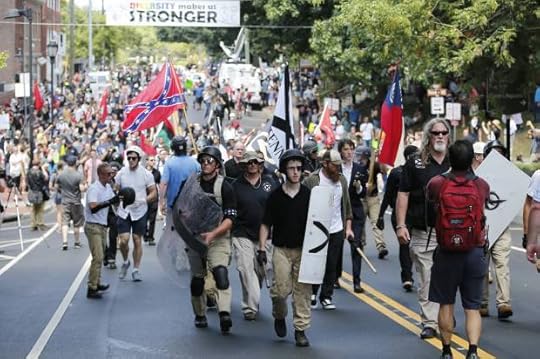
(Credit: AP Photo/Steve Helber)
This Q&A is part of Sarah Jaffe’s series Interviews for Resistance, in which she speaks with organizers, troublemakers and thinkers who are doing the hard work of fighting back against America’s corporate and political powers. This interview has been edited for length and clarity.
The events over the weekend in Charlottesville, Virginia have resounded across the nation. It took the president three days to condemn the white nationalist, neo-Nazi and KKK groups gathered to spread fear and hatred among the community of Charlottesville and the nation at large. Sarah Jaffe spoke with Lisa Woolfork of Black Lives Matter Charlottesville about how a strong coalition of groups counter-programmed the day of the march from beginning to end.
Sarah Jaffe: How are you holding up?
Lisa Woolfork: No black woman, like myself, would have been wandering around anywhere down here by themselves yesterday. So, that is a big shift.
SJ: So the last time there was a white supremacist rally in Charlottesville was not that long ago.
LW: We had that torch rally around the Lee statue. I think in May they had an event. In July, of course, the Klan. Then, August, it is this one. We have started calling this the Summer of Hate.
SJ: This one was obviously a bit of an escalation for them, but tell me how your went day yesterday. What was going on where you were?
LW: I began the day at the First Baptist Church on Main Street. It is a historic African-American church that did a service to galvanize people to come out and stand up for their community. There were wonderful messages given there. Rev. Traci Blackmon from the United Church of Christ, she spoke. Cornel West, who is a well-known activist, he spoke. There were song selections. The service a sunrise service and began at 6 a.m. Then, we walked over to the Jefferson School and a group of us proceeded from there to McGuffey Park.
At McGuffey Park, there was programming. There was a gigantic live theatre puppet show with a gigantic puppet of Sally Hemings that was 15 feet tall and other props to tell the story about Charlottesville and the march. That was by a wonderful team of very creative activist artists. It is a community called Charis Community. That is just an example of, basically togetherness.
SJ: Particularly coming into this rally, what was the plan that folks had for dealing with this day?
One of the strengths of coalition based activism is that it allows for a variety of approaches. Unlike the Klan rally, which was much more focused on a particular single place and time — I was involved in different seminars and symposia surrounding that, as well as some activism on the ground — this was much more dispersed. We understood that this was not meant to be a one and done type gathering for the “alt-right.” It was meant to be basically a weekend party where they would come in on Friday and then they leave on Sunday.
Our goal was to help pull the community to respond to the larger, more capacious threat of the “alt-right” and the white supremacists, neo-Nazis, white nationalists were representing and threatening to bring forward. I think we were able to do that. We were able to bring together a variety of people, several groups issued individual calls. The clergy, for example, had a really wonderful one calling on, in particular, white people of faith, white ministers, white clergy to come and join in taking a stand against not just explicit violent racism, but also the subtle institutional racism that their own institutions had created and cultivated over time. It was I think a really powerful soul searching on the part of the clergy, for example. I was very gratified and encouraged to see that so many in the community, as well as visitors and people from other allied organizations and people who had no connection to Charlottesville and weren’t members of any kind of organization. They just wanted to come out and stand on the side of justice.
SJ: Obviously, these people were drawn to Charlottesville not because Charlottesville is uniquely welcoming to white supremacists, but because the symbols there are meaningful to them.
LW: Yes, absolutely. One thing that I like to impress upon is that I think it is very important to retain attention on the Confederate monument. Of course, many people are turning to Louisiana and New Orleans as an example of a mayor who decided to step up and say, “No more. These are relics of a racist past and I want us to build a better future as a city. We do not need these any longer. They have outlived their usefulness.” Charlottesville has not done that. They have not done a complete process of reckoning. There was a commission that worked hard to uncover lots of very interesting information about Charlottesville’s unique Southern history, but the recommendation that they made — there were two recommendations. One was to remove the statue and the other was to re-contextualize them in place.
I have always been against the re-contextualization argument, because I don’t believe that you can make a huge monument to the Confederacy mean anything other than a monument to the Confederacy. The Monument Fund is the organization that sued the city in court when the city council voted to remove the statues. Now, mind you, they voted to remove them from one place to another. The Monument Fund said in their argument in court was that if the statues were to be moved, it would do them irreparable harm. I really think that we need to concentrate on that claim.
What does it mean that someone’s personal identity is bound up in a racist confederate monument, a monument to white supremacy? For me, the argument about re-contextualization has already been made. I think the best and most honest context for these monuments is white supremacy. Nothing says what these monuments really mean like a thousand white supremacists coming to defend them.
SJ: Speaking of the symbols, there was the controversy about them wanting to have their rally in this particular park that had just been recently renamed, having been named for Robert E. Lee, right?
LW: Yes, that is right. We have a Robert E. Lee statue and that is in Lee Park. Then there is a Stonewall Jackson statue and that was always called Jackson Park. So, they changed Jackson Park to Justice Park and they changed Lee Park to Emancipation Park.
SJ: So the white supremacists had complained and sued over wanting to be able to have their rally in this particular park, even though the city had ruled that they could not.
LW: Yes. They did. They were helped by the Rutherford Institute, which I believe concentrates on free speech issues and constitutional issues here in Virginia. And, they were aided by the ACLU Virginia chapter. The judge, not the city, the judge ultimately ruled that they could hold their rally in Emancipation Park. It was around not wanting a “heckler’s veto” to change anybody’s unpopular views. The judge ruled and sided with the “alt-right,” with the white supremacists, with the Nazis, with the white nationalists.
SJ: At whatever point that their gathering was ruled unlawful and they were pushed out of the park, tell us what happened because that seemed to be when the real violence broke out.
LW: Seeing the Nazis and the “alt-right” retreat from Emancipation Park after their event was declared an unlawful assembly — that was quite a parade of hate. As they were leaving the area, they threw flares, they spit on people. There were several altercations of shouting matches and shoving matches. But still, it was a very powerful display of how love conquers hate. To stand there shoulder to shoulder to shoulder with neighbors, with colleagues from my department in English, with other faculty from around the university that I have seen a few of, from people in my own organization representing Black Lives Matter Charlottesville, which is a very small and new group, has since developed allied connections.
That we had worked to reclaim in some small part that promise that America makes to all of us and that is the promise of equity, the promise that the Constitution shouldn’t be used as a battering ram, it shouldn’t be used as a weapon to deprive other people of rights. That was pretty heartening.
I would say that the real violence was allowing these confederate monuments to remain in the center of our city as a paean or a testament or an endorsement of not just 19th-century white supremacy, but 21st-century endorsement or tolerance of white supremacy. I think that is something that I would certainly emphasize. There are so many ways to think about and define violence.
SJ: Let’s talk about the organizing leading up to this.
LW: The way that we have been working is in a coalition basis. We believe that we are stronger together than separate. Groups like Congregate, which is a collection of different faith organizations and pastors, ministers, rabbis from a variety of different faith traditions, SURJ, Showing Up for Racial Justice and Black Lives Matter Charlottesville are a constellation of groups that are trying to mobilize our community for the greater good.
SJ: You said you were on your way to a vigil. Tell me, what is next? What are people planning going forward from this weekend?
LW: As a coalition, our goal is to continue in the vein in which we have started. I know, particularly, that Charlottesville Black Lives Matter is interested in talking more about the Confederate statues and how these monuments should be removed and how the city council should work hard to fight in court against the legal challenges that we might face. We want the city council to basically care as much about the lives of citizens as they did about preserving the rights of the “alt-right” when they allowed their permit to go through. We want the city to be committed to questions of racial justice and to appreciate that in the age in which we are living racist rhetoric is not just talk. Racist rhetoric produces racist actions. Racist statues are not just art. Symbolic racism is rooted in actual racist actions.
SJ: How can people keep up with you and with Charlottesville BLM?
LW: Please check Charlottesville BLM’s Facebook page. We do a lot of updates through there. We also have a Twitter feed. They can follow us there, as well.
Eclipse of reason: Why do people disbelieve scientists?
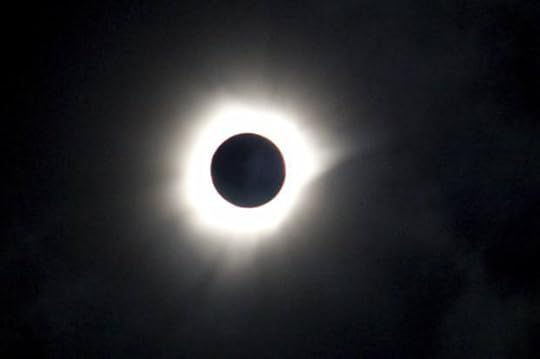
A total solar eclipse is seen in Luwuk, Central Sulawesi, Indonesia, Wednesday, March 9, 2016. A total solar eclipse was witnessed along a narrow path that stretched across Indonesia while in other parts of Asia a partial eclipse was visible. (AP Photo/Irmansyah) (Credit: AP Photo/Irmansyah)
If you’ve been paying attention, you know that on Aug. 21, we’re in for a special cosmic treat: the Great American Eclipse of 2017.
The moon’s shadow will track a 4,000-kilometre course across the continental United States from coast to coast, beginning with Depoe Bay, Ore., and end after 93 minutes in McClellanville, S.C.. As a result, tens of millions of Americans will be treated to that rarest of natural wonders: a total eclipse of the sun.
Canada, unfortunately, won’t experience a total eclipse, but the view will still be impressive: The sun will be 86 per cent eclipsed in Vancouver, 70 per cent in Toronto, and 58 per cent in Montreal. Canadians who want to experience totality from the comfort of home will need to wait until April 8, 2024 (Hamilton, Montreal and Fredericton), Aug. 23, 2044 (Edmonton and Calgary) or May 1, 2079 (Saint John and Moncton).
In the meantime, back here in 2017, everyone is focused on Aug. 21. Under the path of the eclipse, schools will be closed, traffic will be a nightmare, and hotel rooms at the Days Inn are on offer for $1,600 a night.
Absolute faith in eclipse predictions
What is remarkable among all this excitement and frenzy is the lack of “eclipse deniers.” Nobody doubts or disputes the detailed scientific predictions of what will happen.
I will be watching the eclipse from Simpson County, Ky., where I expect I will be joined by thousands of others, all of us knowing in advance that totality for us will begin at 1:26:44 p.m., and will end 141 seconds later. It is inconceivable to any of us that the predictions will be wrong by even a single second.
Not one person will argue beforehand that the jury is still out on eclipses, that scientists have tampered with the data, that eclipses are faked by NASA, that exposing children to eclipses causes autism or even that eclipses are a Chinese hoax. Across the continent, there will be climate deniers, creationists, anti-vaxxers and flat-Earthers looking upwards through their eclipse glasses, all soaking up this wondrous moment along with everyone else.
[Editor’s note: Astrophysicist and popular science communicator Neil deGrasse Tyson also echoed this article’s core assertion while it was in editing.]
This presents a puzzle: Why do people distrust or dispute so many aspects of science, but unanimously accept, without question, the ridiculously specific predictions on offer for every eclipse?
Why the selective denial of science?
One possible reason is that we’ve been right on eclipses every time before. But for most people, a total eclipse is a once-in-a-lifetime experience. Most people won’t have experienced such predictions first hand, and will have to take it on trust that what’s happened before for others will happen again for them.
Another explanation might be that, unlike the case for climate change or vaccinations, the science behind eclipses is simple and uncontroversial. While it’s true that astronomers have been making reasonably accurate eclipse predictions for thousands of years, the required calculations are highly complex, extending far beyond the mathematics covered in high school or even in many university courses. Most people would find it difficult to reproduce or confirm any of these eclipse predictions for themselves.
The more likely answer is that eclipses are not a threat. There is nothing at stake. Eclipses do not endanger our way of life or our standard of living. Nobody fears that eclipses might have economic implications, could challenge our belief system or threaten our children. There are no anti-eclipse lobby groups trying to set the narrative, and there are thus no well-funded advertising campaigns or scientific studies that aim to raise doubts in our minds or to subtly shape our thinking.
Laws of science
Eclipses are agenda-free. The science — and the resulting extraordinary experience — are left to speak for themselves.
The problem is that we don’t get to pick and choose what scientific facts or consensuses are controversial, and which are not. The same strict laws of science are everywhere.
So if you’re comfortable putting down your non-refundable deposit for your eclipse hotel, if you let a steel tube flying at 30,000 feet carry you to a town under the path of totality, if on the morning of Aug. 21 you check the weather forecast hoping for clear skies, if you pay for breakfast with your credit card, and if that afternoon you snap a picture of the eclipse with your smartphone, then you have staked your bank balance, your August vacation and your very life on the fact that science is testable and reproducible, and that faulty theories can’t withstand extended scrutiny and testing.
 Total solar eclipses are a strange cosmic coincidence and a remarkable, awe-inspiring experience. But they are also a profound reminder that when the emotions, money and politics are stripped away, none of us, at our core, are science deniers.
Total solar eclipses are a strange cosmic coincidence and a remarkable, awe-inspiring experience. But they are also a profound reminder that when the emotions, money and politics are stripped away, none of us, at our core, are science deniers.
Bryan Gaensler, Director, Dunlap Institute for Astronomy and Astrophysics, University of Toronto
Facebook gave a neo-nazi website a huge assist in spreading hate after Charlottesville
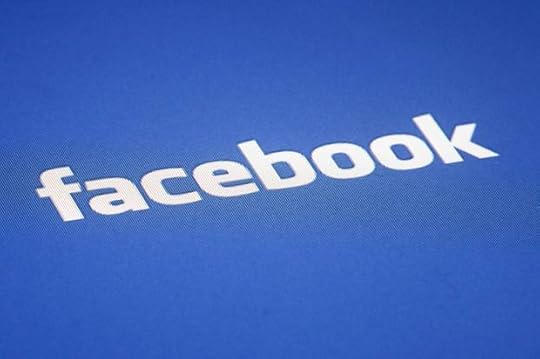
(Credit: AP/James H. Collins)
If you’re following the Daily Stormer drama, you know that the alt-right neo-Nazi site is in hot water. After Heather Heyer was killed in a domestic terrorist attack following the white supremacist rally and ensuing riot in Charlottesville over the weekend, the Daily Stormer published a venomous article denouncing Heyer as a “Fat, Childless 32-Year-Old Slut.” GoDaddy has revoked the website’s domain name, and Google is punishing it too. That’s all well and good, but you may have missed Facebook’s huge role in helping the piece going viral.
Over the weekend, the article was a top result in Facebook searches under the “News” category, earning a massive share count. One reader reported on Twitter that the piece had been shared on Facebook 90K times as of Monday night.
also if ur wondering how garbage like daily stormer is disseminated, that story has 65 THOUSAND shares on @facebook & is listed under news. pic.twitter.com/KykJOjPbq8
— susie banikarim (@banikarim) August 13, 2017
The Daily Stormer is a self-proclaimed white supremacist site that routinely targets African Americans, Jews, and Arabs, promotes the use of the hashtag #HitlerWasRight and endorses the use of eugenics, among countless other offenses. It’s vile, even beyond the likes of Breitbart and the Daily Caller.
It’s not news that Facebook’s algorithm has a huge impact on the Daily Stormer’s (and all other publishers’) readership. In 2016, Gizmodo reported that Facebook News curators admitted to suppressing right-wing stories, greatly impacting traffic to those sites. The social media platform came under fire again for boosting fake news stories during the 2016 election, and since then, has been on a crusade against fake news with the help of fact-checking organizations like Poynter and Snopes. To reverse the damage it helped cause, Facebook is now deleting links to the Daily Stormer article about Heather Heyer. But it’s far too little, too late.
There will always be evil, offensive people like the writers and editors at the Daily Stormer who will spin a tragedy like Charlottesville into cash. But the real danger lies in media monoliths like Facebook promoting their work. Certainly, the site has done a much better job than Twitter derailing hate speech on the internet. But many thousands of readers only found that Daily Stormer piece because Facebook automatically and unwittingly characterized it as “news.”
In digital media, where pageviews from even the most odious sources mean advertising revenue, the Daily Stormer will probably be laughing all the way to the bank. That is, assuming they still have a website this time next week.
August 16, 2017
Charlottesville: One battle in a war for America’s very soul
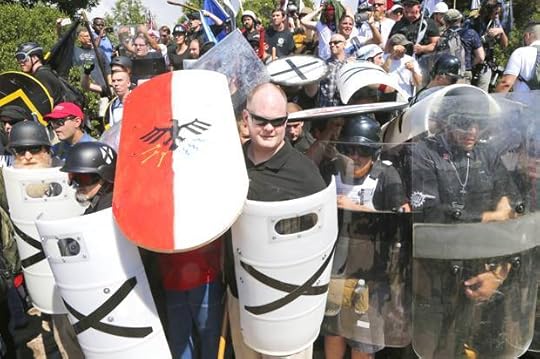
White nationalist demonstrators use shields as they guard the entrance to Lee Park in Charlottesville, Va. (Credit: AP/Steve Helber)
I’ve been going to Charlottesville, Virginia to visit relatives and the home of my ancestors since I was four years old. Practically every summer we used to visit my great-grandmother, Mary Walker Randolph, a great-great-granddaughter of Thomas Jefferson, who lived there in a little house they called Wild Acres with her daughters Agnes and Mary Walker, who we called Aunt Aggie and Miss Moo, my great aunts and third great-granddaughters of Jefferson. My great-uncles Hollins and Tom Randolph lived nearby, and so did my great-aunt Carolina. All of them and my grandmother Sara Randolph Truscott were born at Edgehill, a former plantation a couple of miles from Monticello that had been owned by their great-grandmother, Martha Jefferson Randolph, Thomas Jefferson’s oldest daughter, and her husband Thomas Mann Randolph.
The truth about my family history was hidden from me by my relatives back then, just as white supremacists and others among us seek to hide and deny our history today. The truth was, my great-grandmother’s father and mother were slave owners. In fact, every person I’m related to through the Jeffersons and the Randolphs owned slaves in the early days of Virginia, which would seem to make the legacy of my family in that state a complicated one, except it’s not complicated at all. Owning slaves was wrong and not just by the moral standards we would apply today.
Most, if not all, of Jefferson’s political compatriots from the North opposed slavery at the time Jefferson wrote “all men are created equal” in the Declaration of Independence, the founding document of this nation. A contentious battle was fought over the issue of slavery at the Constitutional Convention, resulting in the infamous 3/5ths compromise, enshrining this country’s original sin in the document establishing the laws under which the United States of America was to be governed and is still governed today. The failure to resolve the issue of slavery at the founding of the nation led directly, seven decades later, to the secession of the slave owning states from the Union, the formation of the Confederacy and the Civil War. More than 435,000 Union soldiers gave their lives in combat or perished from disease fighting to end slavery and the institution of white supremacy and to maintain the Union. More than 258,000 Confederate soldiers were killed in combat or died from disease fighting to preserve slavery and white supremacy. The nearly 700,000 who died in that war far exceeds the total number of Americans killed in all wars fought by the Unites States combined.
To that astounding number we must now add one. 32-year-old Heather D. Heyer was killed at a protest against the rally by white supremacists in Charlottesville on Saturday afternoon when one of the white supremacist demonstrators, James Alex Fields Jr., 20, drove his car at high speed into a crowd of counter demonstrators in an act of terrorism. The white supremacists and Nazi sympathizers had gathered to protest the pending removal of a statue of Confederate General Robert E. Lee from Emancipation Park in Charlottesville. It would seem that the Union’s victory in the Civil War would have settled the issue of slavery and white supremacy for good. But the Confederacy and Civil War generals like Lee and Stonewall Jackson have their defenders, and white supremacists cling to their spurious “honor” and seek to deny the reality of what they did. The clash over the statue of Lee between defenders of white supremacy and their opponents is being described as a stain on Charlottesville, in normal times, a quiet town of leafy streets and the grand campus of Jefferson’s University of Virginia. But the stain was there all along, the stain of slavery and of white supremacy, which Jefferson infamously defended in the only book he ever wrote, “Notes on the State of Virginia.”
How to deal with the legacy of slavery and the Civil War in the South is a contentious one, but it shouldn’t be. All over the South, grand statues stand in public squares and parks celebrating the heroes of the Confederacy — Jefferson Davis, Robert E. Lee, Nathan Bedford Forrest, J.E.B. Stuart and many others. It’s one of the great American ironies — a uniquely Southern one to be exact — that they erected these monuments to celebrate a bunch of generals who lost a war and the cause they were fighting for — white supremacy. These monuments to a lost cause were erected during the days of Reconstruction and Jim Crow in an attempt to oppress African-Americans and show them that whites were still in charge in the South. It’s as if Germany had erected statues celebrating General Rommel and General Kesslering and General Von Rundstedt, the Nazi generals who lost World War II and the cause they were fighting for — Aryan supremacy — in order to show Jews and gypsies and homosexuals who was still boss.
Charlottesville has begun an attempt to redress this contradiction by taking down the statue of General Lee from a public park and moving it to another location, where Lee and his role in the Civil War can be displayed in context. The proper way to view Lee, I believe, would be as a traitor to his nation who defended an immoral institution in an unjust and insane war. I doubt that will be the context in which his statue ends up being displayed in Charlottesville, but anything at all will be better than celebrating a man with such an inglorious past. The protest by white supremacists and Nazi sympathizers last Saturday was against this attempt to correct the historical record. They came armed with firearms, clubs and projectiles, wearing camouflage clothing, helmets and in some cases bulletproof vests, to make their statement in defense of Robert E. Lee and white supremacy. They came, it would seem, to continue fighting a war that was lost 152 years ago. They left one dead and 19 injured, but they lost the battle of Charlottesville just as the South lost the Civil War.
I visited Charlottesville for a couple of weeks earlier this summer. My 16-year-old son was working as an intern at Monticello, and my 10-year-old daughter attended the Monticello day camp for children. I have my own legacy at Monticello — I was the first and only white Jefferson descendant to invite my African-American cousins who are the descendants of Sally Hemings and Jefferson to accompany me to the family reunion on the mountain back in 1999. I spent the next four years inviting my Hemings cousins to Monticello every May, trying to convince the white descendants to welcome them into the family. We were unsuccessful, but the presence of the Sally Hemings descendants at Monticello changed the place forever. I wanted my kids to learn about my part of our family history and to get a sense of the peculiar legacy left to us by our great grandfather Thomas Jefferson. It is a mixed legacy. The man who wrote the Declaration of Independence owned more than 600 slaves during his lifetime and had a family of six children with one of them. After Jefferson left the presidency and took up his life at Monticello, there were many, many days when there was only one white man and over 100 slaves on that mountaintop.
It was possible to take a tour of Monticello as late as the 1990’s and never hear the word “slave” uttered. But the place they call “Thomas Jefferson’s Monticello” was always his in name only. He may have designed the house, but his slaves built it. Monticello arguably belongs to its enslaved community more than to its master. The Thomas Jefferson Foundation, which owns and cares for Monticello, is today seeking to redress this inequity. A tapestry is being woven using archeology, the written record and the oral history of descendants of slaves, and slowly a picture of the lives of the slaves who built and worked at Monticello is being revealed. Today, tour guides on the mountain point to the work done by slaves and the remnants of their lives, and it is everywhere. They are excavating the ground around the joinery, where John Hemings, the brother of Sally, built furniture and did the fine woodwork that ended up in the interiors of Monticello and Jefferson’s summer home, Poplar Forest. Recently, a public restroom was excavated which had been built within the slave quarters that comprised the “dependencies” attached to Monticello. There was discovered the remains of rooms occupied by Sally Hemings and her brother James, Jefferson’s cook who had been trained at the Cordon Bleu in Paris when Jefferson served as ambassador there. Elsewhere on the mountain, there are excavations of small communities built by slaves who worked in various sections of the plantation farming the crops and tending to farm animals. And down the mountain, just below the Jefferson family cemetery where my great-grandparents and aunts and uncles and mother and father and brother Frank are buried — where one day I will join them — a slave cemetery was discovered and preserved.
The history being revealed day after day at Monticello isn’t slave history. It is American history, a part of the story of our nation that has not been adequately told in textbooks in primary and secondary schools and colleges and celebrated in public squares by the erection of great statues. Where, for example, is the statue to the slaves who built the White House and the Capitol building in Washington, D.C.? Where is the statue to the slaves who worked the cotton fields and provided the raw material for the factories in the north, which wove the fabric that made the garments which clothed Americans as they moved west and expanded the United States? Where are the statues of the black Americans who fought on the side of the Union in the Civil War? Where are the statues honoring the slaves who built the grand downtowns of capital cities of Richmond and Atlanta and Columbia and Raleigh and Jackson and Montgomery and Baton Rouge? There are streets and highways all over the South named after Confederate generals like John Mosby and John Bell Hood. Apart from a few boulevards here and there named for civil rights heroes like Martin Luther King and Rosa Parks, where are the names of the slaves who actually built those streets and roads? Where are the statues in the public plazas honoring the towering figures of the civil rights movement who came along later and turned dreams into reality, wrongs into rights?
This is the history that the white supremacists who rioted in Charlottesville were trying to suppress by protesting the removal of the statue of Robert E. Lee. They realize that the negative space left in Emancipation Park will be filled with history they seek to deny — a history of accomplishment and honor of African-Americans that puts the lie to white supremacy. Why these people are so uncomfortable with this history is a mystery to me. Our history is so complex and rich and filled to the brim with contradictions and unknowns. This is the reason our history is worth exploring and revealing, because it is at once so wondrous and horrifying, beautiful and ugly. It is, in short, human.
The white supremacists and Nazi sympathizers who went to Charlottesville last weekend and marched with torches and displayed Confederate and Nazi flags fought a battle they did not win in a war that was already lost. That Donald Trump refused to call them out for their prejudice and hate last Saturday, and doubled down by overtly and outrageously taking their side on Tuesday, is all the evidence you need that his presidency is an empty vessel containing not a shred of decency or honor. Because of this, he will not last. Trump doesn’t seem to realize that it’s possible to be proud of America, warts and all. It isn’t what’s right about us that makes this country worth celebrating. It’s what’s wrong with us and our willingness to fix it that makes America great. A lot of Americans have given their lives in this cause over the years. One more fell last Saturday. They should put up a plaque on the street where Heather Heyer was killed, honoring her sacrifice in the battle of Charlottesville. We won this time, but there is still a war to fight against Trump and his Nazis and white supremacists and what they stand for. This isn’t just politics. We are fighting for our nation’s soul.
Netflix’s “The Defenders” isn’t the best Marvel series, but it may be what we need right now
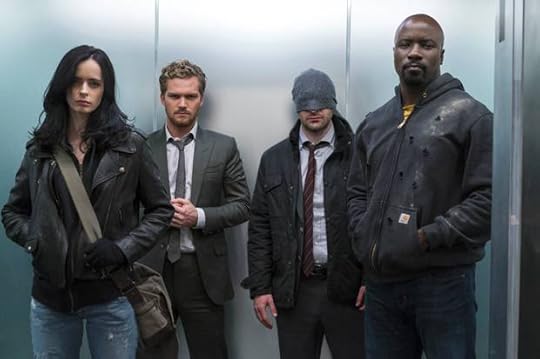
Was Christopher Nolan’s “Dunkirk” whitewashed? And if so, what does that mean?
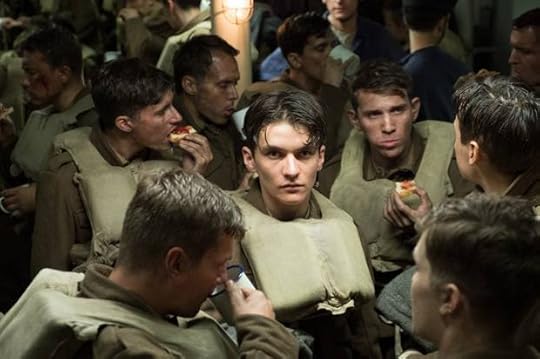
Fionn Whitehead as Tommy in "Dunkirk" (Credit: Warner Bros./Melinda Sue Gordon)
We can’t consider the “Dunkirk” whitewashing controversy without at least mentioning the recent resurgence of white nationalism.
From the election of Donald Trump and the upsurge of far-right violence that culminated last weekend in Charlottesville to parallel developments in Europe and the rest of the West, the world is discovering that racism, misogyny, anti-Semitism and xenophobia remain nearly as potent in 2017 as they were in 1940. That was the year, of course, in which the British army had to stage its dramatic retreat from France during the famous Battle of Dunkirk. That great escape quite likely stopped the Nazis from total victory in Western Europe and paved the way for the Allies’ victory five years later.
But racism doesn’t have to be violent or hateful — or, for that matter, even intentional — to be pernicious. This point became clear when British-based writer Sunny Singh wrote a piece for the Guardian skewering Christopher Nolan’s film “Dunkirk” — which is certainly not on the side of the Nazis — for alleged historical whitewashing.
The movie, Singh wrote, “erases the Royal Indian Army Services Corp companies, which were not only on the beach, but tasked with transporting supplies over terrain that was inaccessible for the British Expeditionary Force’s motorised transport companies. It also ignores the fact that by 1938, lascars – mostly from South Asia and East Africa – counted for one of four crewmen on British merchant vessels, and thus participated in large numbers in the evacuation.”
This point was echoed by Case Western Reserve professor John Broich in a Slate editorial. “In the film, we see at least one French soldier who might be African. In fact, soldiers from Morocco, Algeria, Tunisia, and elsewhere were key to delaying the German attack. Other African soldiers made it to England and helped form the nucleus of the Free French forces that soon took the fight to the Axis. Soldiers from West and North Africa were key to delaying the German attack.”
Broich added, “There were also four companies of the Royal Indian Army Service Corps on those beaches. Observers said they were particularly cool under fire and well-organized during the retreat. They weren’t large in number, maybe a few hundred among hundreds of thousands, but their appearance in the film would have provided a good reminder of how utterly central the role of the Indian Army was in the war. Their service meant the difference between victory and defeat. In fact, while Britain and other allies were licking their wounds after Dunkirk, the Indian Army picked up the slack in North Africa and the Middle East.”
Singh and Broich are hardly alone in accusing the film of being a whitewash. As Oxford professor Yasmin Khan wrote in The New York Times, “Britain was always dependent on the colonies — in India, Southeast Asia, Africa and the Caribbean — for men, materials and support, but never more so than in World War II. Some five million from the empire joined the military services. Britain didn’t fight World War II — the British Empire did.”
To address the whitewashing controversy, Salon reached out to Joshua Levine, who served as Nolan’s historical consultant on “Dunkirk” (which I reviewed here), for his thoughts on the whitewashing controversy.
“Members of the Royal Indian Army Service Corps served in France in 1939 and 1940,” Levine explained. “The majority of them were evacuated to England before Operation Dynamo [the Dunkirk evacuation] began – although a small number were evacuated from Dunkirk during the very early part of Dynamo. So the film could conceivably have shown Indian soldiers. But that isn’t the same as saying that it ought to have done so. It isn’t this film – or any film’s – job to tell the full story of Dunkirk.”
Levine added, “Nolan’s film focuses on a few protagonists whose paths cross occasionally, each one of whom experiences just a tiny corner of the whole story. As Hilary Mantel has said about historical fiction, ‘The man who is fighting can’t see over the hill, out of the trench.’ It is unlikely, in reality, that a soldier at Dunkirk would have encountered any Indian soldiers. And while some viewers and commentators might prefer the film to feature members of the RIASC, that’s a matter of preference — and I don’t think it’s justified to claim that the film ‘whitewashes’ the story of Dunkirk.”
The historian then closed his comments with this observation: “At the same time, I’d love to see an Indian film about Dunkirk, or the Second World War generally, and I really hope that Indian filmmakers are working on it.”
There may be a legitimate artistic case for limiting the main narrative of “Dunkirk” to the perspective of a handful of characters. But it shouldn’t be the sole responsibility of artists of color to incorporate the perspectives of nonwhite characters in fictional accounts of historical events. In order to effectively fight racial bigotry — whether the worldwide terror presented by Hitler in 1940s or its alt-right echo today — one must do more than wage war against the bad guys. Sometimes we have to acknowledge bias that is much harder to see.




